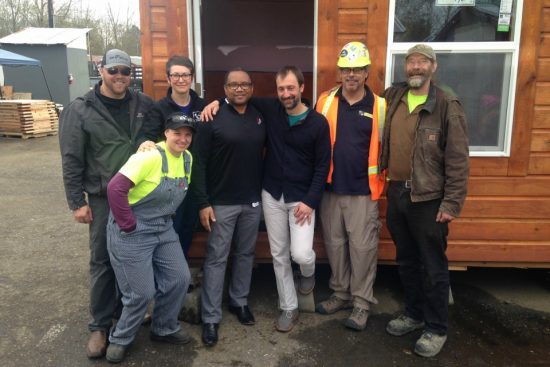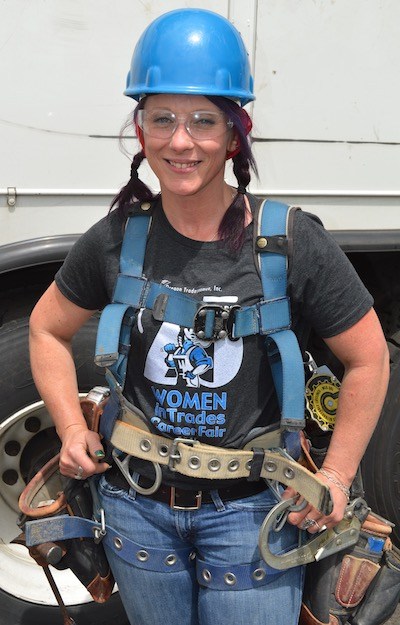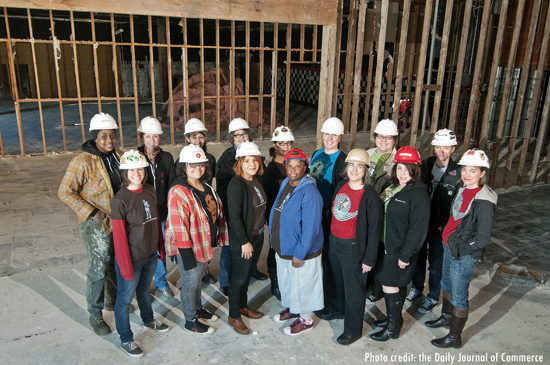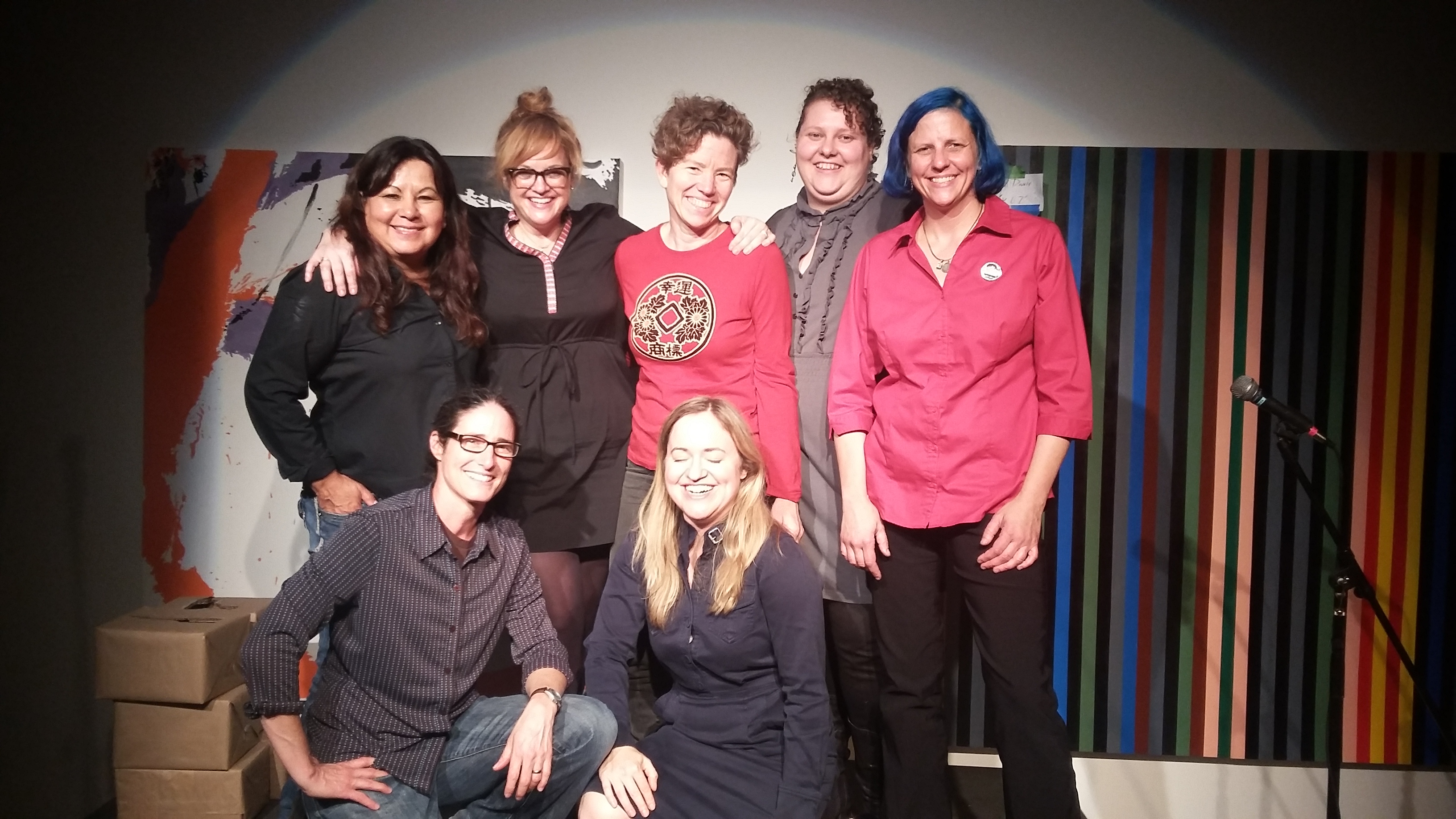Media Coverage of OTI
Oregon Tradeswomen is Made For This
Made For This is a new initiative coming from KGW, Portland’s local NBC channel, that aims to highlight career options in the skilled trades! After decades of societal messaging that reinforces the idea that going to college is the only way to start a good career, KGW is working to change that narrative by promoting alternative pathways to meaningful careers such as pre-apprenticeship and registered apprenticeship. These career pathways offer transferable skills, paid on-the-job training, and come without the burden of college debt.
Through a partnership with Oregon’s Bureau of Labor and Industry (BOLI) and the Oregon Department of Transportation (ODOT), Oregon Tradeswomen was given the spotlight to feature our Trades and Apprenticeship Career Class (TACC) and one of our successful pre-apprenticeship graduates for Made For This.
Our first venture with Made For This was a promotional video that featured union Laborer with LiUNA Local 737 Kaysha Yarnell. Kaysha is an Oregon Tradeswomen graduate who recently completed her apprenticeship with LiUNA. We had a lot of fun filming Kaysha at the Laborer’s Training Center as she works alongside her fellow Laborers. Watch Kaysha’s video…
Oregon Tradeswomen staff was also invited to join host Lacey Evans on Hello Rose City, KGW’s morning show highlighting the latest trends in Oregon and SW Washington. Our Training Manager Zoe Stansbury and Admissions Coordinator Elle Madison went live on August 21st to spread the word about Oregon Tradeswomen’s TACC program and how TACC can help women jumpstart their careers in the skilled trades. Check out Oregon Tradeswomen on Hello Rose City…
We are so grateful to BOLI, ODOT, and KGW for the opportunity to highlight the work we do at Oregon Tradeswomen and give visibility to women in the trades. With this industry being disproportionately male-dominated, every ounce of representation makes a huge difference to show that women are Made For This!
2021 DJC Building Diversity Awards

- GeoEngineers
- Todd Duwe, Perlo Construction
- Meyer Memorial Trust headquarters project
- Mel Jones, JE Dunn Construction
- Román Hernández, Troutman Pepper
- Kelly Kupcak, Oregon Tradeswomen Inc.
- Wenaha Group
- Portland Building reconstruction project
- RKm Development
- The Skanner (lifetime achievement award)
- Center for Equity & Inclusion
- Advanced Tribal LLC
- Hacienda Community Development Corp.
- Angela Watkins, Minority Construction Group and Constructing Hope
- NAMC University
- Safe from Hate initiative
Portland Metro Region Construction Workforce Market Study

Oregon Tradeswomen works to increase the number of women and people of color entering the skilled trades, but there are still significant barriers that make recruitment and retention of a challenge. A Workforce Market Study was jointly commissioned in January 2017 by The City of Portland and Metro, (Oregon regional governance and the only one in the nation), with the support of Oregon Tradeswomen, the National Association of Minority Contractors of Oregon (NAMCO), Oregon Employment Department (OED), Portland State University (PSU), and Worksystems Inc. to learn more about how to invest in equitable growth through diversifying our workforce.
Why should we care about diversifying our workforce? The new report states, “Diversifying the construction workforce will not only help create a stronger supply of needed workers for the industry, it will also directly address issues of poverty and economic mobility within communities of color and working families in the region.” The construction industry is also in the midst of a labor shortage. Ideally, we can prepare women and minorities to be those ideal candidates to help fill the labor gap. It isn’t as easy as it seems, though, as the study identifies barriers that make recruitment and retention of these demographics a challenge.
The study outlined 9 main barriers that hinder recruitment and retention of women and minorities in the trades. Many trades jobs come from personal referral, say from a father or friend who is already in the industry. The study shows that women and minorities have less of these gateway experiences. This goes hand in hand with the fact that there are not many communities or social networks within the industry for women and people of color which minimizes the exposure someone from those communities might have to the trades. It was also found that marginalized communities face more hardships than others due to financial issues, child care, transportation, among other things that can stand in the way of them continuing their careers.
Although Oregon Tradeswomen does great work preparing women to join the construction workforce and gives them support throughout their careers, however, there are limits to our capacity to train students, primarily due to structural limitations as to when we can conduct training and offer hands-on experiences to build skills. More than 1,100 women seek our pre-apprenticeship training each year. The problem isn’t that women aren’t interested in a career in construction, but rather, we have a limited number of slots in each cohort. This is a common barrier among pre-apprenticeship and job-readiness programs.
Some of the other barriers that keep women and people of color from continuing a career in the trades are the outdated policies that shape noninclusive jobsite cultures where women and people of color experience sexist and racist attitudes. These policies can foster hostile work environments, poor-quality training for new workers (which then makes it harder for those workers to excel and advance), and fewer opportunities for promotion for women and people of color.
As a way to address the disparity in our region, the study outlined three goals:
- Increase recruitment of diverse workers
- Increase retention of diverse workers
- Develop more robust equity policy and practices
Each of the goals are broken down into action items such as “Ensure steady funding streams to increase capacity of pre-apprenticeship programs,” “Address construction job site culture through respectful workplace trainings with proven results,” and “Enforce contract goals with consequences of non-compliance.”
While there is much work to be done, this study clearly marks a path that we as a community, and hopefully one day as a country, can work towards. There are countless women and people of color who are willing and able to do good work in the construction industry and help fill the labor shortage, but it is the industry as a whole that needs to step up to properly set these workers up for success.
Read the full Portland Metro Region Construction Workforce Market Study.
Our Students Help Build Four New Tiny Homes in Dignity Village
On April 4th, four new tiny homes were unveiled at Dignity Village, one of Portland’s oldest city-recognized camps which is a membership-based community providing shelter to more than 50 people. Many of the structures are more than 15 years old and have problems with mold, leaks, and pests. To help improve the situation, a few local nonprofits, including Oregon Tradeswomen and The ReBuilding Center, came together to build better homes for the camp.

Not only does this project benefit the community, but it gives our students the invaluable opportunity to get hands-on construction experience. This is incredibly important to our Training Director, Amy James Neel:
“Building small structures provides students with a unique opportunity to touch multiple aspects of residential construction on a condensed timeline. The building skills they develop during class prepares them to integrate into professional trades jobs where they will make a living wage. The partnership between the ReBuilding Center and Oregon Tradeswomen allows our students to build safe structures for our community while also building their own confidence that they belong in the skilled trades.”

We are beaming with pride for our students, both for their exemplary work and for this important contribution to our community!
Tradeswomen in the News!
Oregon Tradeswomen and our graduates have been in the news recently and we wanted to put all the links here in case there were stories you missed on our social media channels!

Oregon Tradeswomen Names Executive Director
Daily Journal of Commerce | May 16
Video series: Isis Harris, electrician apprentice
Oregon Business Magazine | May 17
KGW’s Drew Carney Previews the Women in Trades Career Fair
KGW Northwest NewsChannel 8 | May 19
Women in the Trades
NW Labor Press | May 31
Women in Trades: Meet Danielle Marcial, Water Operations Mechanic
Website Story June 2017
Tradeswomen’s Fight for Gender Equity
Huffington Post | June 1
The Portland Tribune Highlights the Experiences of Tradeswomen

Portland Tribune reporter, Peter Korn, contacted OTI’s Communications Manager, Mary Ann Naylor, around the middle of June, 2016. He was working on a story exploring the terms misogyny and sexism, and how women in different occupations might experience either or both on the job. One of the people he was interviewing for his story about misogyny suggested that he really needed to get the perspective of tradeswomen, so he called Mary Ann.
Mary Ann referred Peter to Jenna Smith, an OTI TACC Graduate who attained her journeyman card as a power line tree trimmer, and later – after a fight – attained a second journey man card as a lineworker. After speaking with Jenna about her experiences, he was ignited to share her story more fully. Peter contacted Mary Ann to let her know he was embarking on another journalistic project to document some of the experiences of tradeswomen into a multi-part story to run in consecutive weeks. Mary Ann was, of course, more than happy to support the development of these stories by connecting him to tradeswomen, industry contacts, and providing photos to help fully tell the stories.
Oregon Tradeswomen is incredibly thankful to Mr. Korn for his thoroughness and attention to detail in developing these pieces. These are important stories and many have never been shared publicly before now.
Week 1: Tuesday, June 21, 2016
Is today’s misogyny a ‘different, darker animal,’ or more of same ‘ol sexism?
Week 2: Thursday, June 30, 2016
The Worst Job In Oregon (If You’re A Woman)
Week 3: Tuesday, July 12, 2016
Over the line: harassment keeps women off the job
Week 4: Tuesday, July 19, 2016
Subtle sexism keeps women a step behind
&
Recruiting a better ending for women in the trades
Week 5: Thursday, July 29, 2016
Affirmative action fizzles for women in trades
2016 DJC Newsmaker – Editor’s Choice Award

Oregon Tradeswomen, Inc. (Sam Tenney/DJC)
OTI was absolutely honored to be named a 2016 Newsmaker by the Daily Journal of Commerce (DJC). We were even more thrilled to be named as the Editor’s Choice!
The list of honorees are selected by the DJC editorial after they discuss the people, companies and projects covered covered during the previous 12 months as well as those expected to make headlines during 2016.
In an interview with DJC Editor Stephanie Basalyga, OTI’s Executive Director Connie Ashbrook explained that the services and programs OTI provides are more important than ever.
“There’s more need out there than we have the capacity to serve, both on the part of women that come in our door … and employers,” Ashbrook said. “When our students are ready, they just fly out the door. Employers are hungry for our graduates.”
Read more of Connie’s interview on the DJC website. Thank you to the DJC for this incredible honor!
OTI In the News in November

Wow! Oregon Tradeswomen was in the news multiple times earlier in November! We made a lot of noise about the first ever National Women in Apprenticeship Day, and we invited members of the media to visit our Trades and Apprenticeship Career Class during their hands on learning days when they were hard at work deconstructing and demolishing the interior of the former ‘Sugar Shack’. This work opportunity was made possible through our partnership with Living Cully – an innovative collaboration between non-profit organizations in the Cully Neighborhood in NE Portland: Verde, Hacienda CDC and NAYA (Native American Youth and Family Center).
Women in Apprenticeship Day
Oregonian
Daily Joural of Commerce
NW Labor Press
Deconstruction of Sugar Shack
Daily Journal of Commerce
KATU
KGW
Portland Business Journal
PQ Monthly
How To: Facebook Campaign for Oregon Women in Apprenticeship Day
It’s great that you are as excited as we are about National Women in Apprenticeship Day, Thursday November 5, 2015. Thank you for joining us to make the presence of women in apprenticeship known far and wide. We all know that apprenticeship itself is a very misunderstood concept and within that system, women are unseen. In order to bring this issue to the forefront, we have some tips for a Facebook post to contribute to the campaign and a national conversation. The tips below will give you a chance to let your friends and family know what you do, while connecting to other tradeswomen to create a larger impact!
Anatomy of the Facebook Campaign Post:
In order for you post to have the most effect, make sure that you specify for these posts to be ‘public’.
The Photo:
For this campaign, let’s show the world that women in apprenticeship work! Include a photo (or a video if you have it) of yourself on a job site or doing trades work. Here are some samples to inspire you!
The Text:
You should talk about your experience, your life, your apprenticeship. You want to let your networks know what you do and what that means to you! So, we aren’t crafting your post for you. However, here are some tidbits we are trying to highlight:
- Announce National Women in Apprenticeship Day, 11/5/15
- Explain that apprenticeship means you get an education and paid on the job training!
- Talk about getting a life-long career, not just a job
- Share your story, about how apprenticeship changed your life
- Let folks know, that women only comprise 3% of the trades, nationally
- You can support women in apprenticeship with a donation to your local tradeswomen organization, like Oregon Tradeswomen, Inc. Donors who give a minimum of $10, today, will be eligible to be chosen to win 4 lower-level tickets to a Trailblazers game PLUS a signed jersey from a starter! Learn more at www.tradeswomen.net/donate.
The ‘Hashtag’ (or the connection to a larger campaign!):
Hashtags are an important and essential part of creating a Facebook campaign. When you tag organizations or include hashtags, the connected flurry of activity means that those posts get seen more frequently. Then more people share your post, and the impact grows! So, don’t forget to include some hashtags.
- Essential Hashtags:
- @OregonTradeswomenInc (In order to do this, make sure you already like our Facebook Page.)
- @TradeswomenTaskforce
- #WomenInApprenticeship
- Hashtags for Extra Lift:
- #Tradeswomen
- #NAW2015
- #GiveGuide
- #20PercentIn2020
- Hashtags to Bring Your Union/Employer into the Circle:
- Like your employer or local union and use – @EmployerFacebookAccountName
- Like your international union and use – @InternationalUnionFacebookAccountName
Take it to the next level!
Add the Twibbon look to your Facebook and/or Twitter Account:
Over the past couple of months, you may have seen people change their profile pictures to have an overlay image. Maybe it was for Planned Parenthood with a pink picture that said “#StandwithPP” or Domestic Violence Awareness with a purple tint and a ribbon. Well, we now have a Twibbon for Women in Apprenticeship! It is a white hardhat that will go over the top of your current profile picture on either Facebook or Twitter. To use this, go to Twibbon and search “Women in Apprenticeship”. Click on the link and allow it to access your Facebook or Twitter and the website will take care of the rest for you!
Bring the Conversation to Twitter:
For those of you who are active on Twitter already you can craft a short post ( I am a woman in apprenticeship). Here are some rough ideas for extra hashtags that you could use on twitter (in addition to those above!):
Oregon Governor Kate Brown, Oregon Labor Commissioner Brad Avakian, Oregon Apprenticeship and Training Division
USDOL, US Women’s Bureau, Labor Secretary Perez
Together, we can use National Women in Apprenticeship Day to really bring tradeswomen to the forefront!
Recap: Storytelling and Workshops
As most of you know, we started a new partnership this year with Back Fence PDX. B. Frayn Masters, Mindy Nettifee, and Liz Olufson saw the importance of tradeswomen’s stories and jumped right into creating a storytelling event for OTI! Most folks don’t think twice about how much work an event involves from planning to recruiting to donations and every other little detail. The dedicated staff at Back Fence were there for us, every single step of the way, it was the type of partnership a non-profit dreams about.
This fabulous partnership led to the development of an exciting, appealing event. Demand from the community was even higher than we had expected, Back Fence and OTI fielded dozens of calls from people trying to get tickets at the last minute. We wish that every single person could have joined us, and that is why we hope to replicate this event next year. If you missed the event, you can watch videos from each of the story tellers online:
Sarah Heidler
Laurie Suchan
Jen Netherwood
Bea Jenkins
Of course, the event would not have been such a success without the support of the tradeswomen who took a big risk to get on stage. We are so thankful to Sarah Heidler, Jen Netherwood, Laurie Suchan, Jodi Tillinghast, and Bea Jenkins. Hopefully, some of you are considering telling a story next year!
Friday night was a fun way to bond before we launched into the workshops for the Tradeswomen Leadership Institute. Tradeswomen volunteers, staff from AFSCME, the AFLCIO, and from LERC taught eight workshops for 47 women in attendance. We kicked off the morning with a tour of Benson High School focused on their trades and manufacturing training. Did you know that approximately every two years, the students at Benson design and build a house from the ground up?
Marilee McCall inspired us all with her keynote address. She opened her life to us and shared her path to becoming Mayor Pro-Tem in Woodland, Washington. Marilee was heartfelt in telling her personal journey. Now, she faces challenges regularly for being a woman in leadership but it doesn’t slow her down and she revealed her own secret for dealing with Naysayers. Thanks to Marilee (and Bea for the connection) for showing us one path to leadership.
None of this would have even been possible if it weren’t for the amazing women on our planning committee: Anjeanette Brown, Maddie Ettlin, Irais Gandarilla, Sarah Heidler, Kadence Jimenez, Bea Jenkins, Leigh Jenkins, and Jodi Tillinghast.
Thank you all so much and we look forward to an even more amazing Tradeswomen Leadership Institute in 2016!

